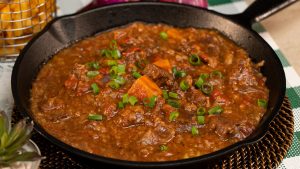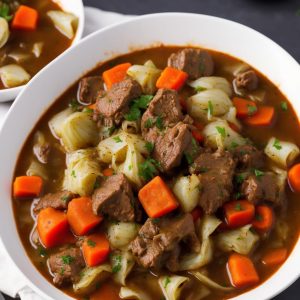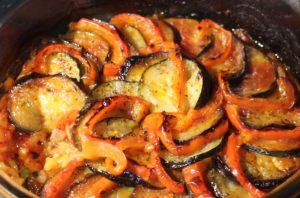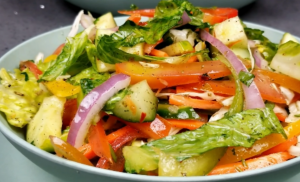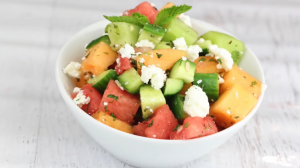This special beef stew recipe is perfect for those chilly winter nights. With the richness of beef, the sweetness of caramelized onions, and the subtle flavors of herbs, it's a dish that warms from the inside out. Whether you're a novice in the kitchen or a seasoned cook, you'll love how simple this recipe is.
The ingredients in this recipe are fairly typical and can be found in most supermarkets. However, the beef bouillon cube and Worcestershire sauce might be located in the condiment or spice aisle. Also, remember to pick a good quality red wine, as it will enhance the flavor of the stew.
Ingredients for the Special Beef Stew
Beef stew meat: The star of the dish, contributing a rich, hearty flavor.
All-purpose flour: Helps to thicken the stew and coat the beef for a flavorful crust.
Olive oil: Used to brown the beef and sauté the onion.
Butter: Adds a creamy richness to the stew.
Yellow onion: Adds a subtle sweetness and complexity to the flavor profile.
Red wine: Helps deglaze the pan and provides depth of flavor.
Beef bouillon cube: Enhances the beefy flavor of the stew.
Potato: Adds a hearty, starchy component to the stew.
Baby carrots: Provide color, texture, and a subtle sweetness.
Rosemary and dried thyme: Give a herby note to the stew.
Garlic powder: Adds a robust, savory element.
Black pepper: Brings a little heat and spice to the stew.
Worcestershire sauce: Its tangy, umami flavor complements the beef well.
One reader, Farrel Hester says:





This special beef stew recipe is a game-changer! The meat is so tender and flavorful, and the combination of herbs and spices is just perfect. It's a hearty and comforting meal that my whole family loves. Plus, it's so easy to make in the slow cooker. Highly recommend!
Techniques Required for Making Special Beef Stew
How to brown the beef: In a skillet over medium heat, heat the oil and brown the beef on all sides. This will help to develop rich flavor and color in the stew.
How to deglaze the skillet: After browning the beef, pour wine into the skillet and use a spoon to scrape up the browned bits from the bottom. This will add depth of flavor to the stew.
How to dissolve the beef bouillon cube: In a cup of hot water, add the beef bouillon cube and stir until it is completely dissolved. This will create a flavorful broth for the stew.
How to cook the stew in a slow cooker: After assembling all the ingredients in the slow cooker, cover it and cook the stew for 7 to 8 hours on low heat. This slow cooking process will tenderize the beef and allow the flavors to meld together beautifully.
How To Make Special Beef Stew
This deliciously comforting beef stew browns the meat in the skillet before slow-cooking it in red wine with herbs and vegetables until tender.
Serves:
Ingredients
- 1lbbeef stew meat,cubed
- 1tbspall purpose flour
- 2tbspolive oil
- 2tspbutter
- 1medium yellow onion,thinly sliced
- ¼cupred wine
- 1beef bouillon cube
- 1cuphot water
- 1large potato,cubed
- ½cupbaby carrots
- ½tsprosemary
- ½tspdried thyme
- ½tbspgarlic powder
- ½tspground black pepper
- ¼cupwater
- 2dashesWorcestershire sauce
Instructions
-
Place the cubed beef and flour in a resealable plastic bag. Seal and shake to evenly coat the beef with flour.
-
Heat the oil in a skillet over medium heat, and brown the beef on all sides. Transfer to a slow cooker.
-
Melt the butter in the skillet over medium heat, and cook onion until tender. Transfer to the slow cooker with the beef.
-
Pour wine into the skillet to deglaze, then pour wine into the slow cooker. Dissolve the beef bouillon cube in 1 cup of hot water, and pour into the slow cooker.
-
Place the potato and carrots in the slow cooker, and season with rosemary, thyme, garlic powder, and pepper. Mix in remaining water and Worcestershire sauce. Add more water if needed to cover all the ingredients.
-
Cover the slow cooker, and cook the stew for 7 to 8 hours on Low.
-
Serve warm, and enjoy!
Nutrition
- Calories: 225.29kcal
- Fat: 9.56g
- Saturated Fat: 2.98g
- Trans Fat: 0.24g
- Monounsaturated Fat: 5.53g
- Polyunsaturated Fat: 0.80g
- Carbohydrates: 15.54g
- Fiber: 2.15g
- Sugar: 1.93g
- Protein: 18.29g
- Cholesterol: 51.04mg
- Sodium: 221.53mg
- Calcium: 31.37mg
- Potassium: 623.21mg
- Iron: 2.52mg
- Vitamin A: 81.60µg
- Vitamin C: 13.83mg
Expert Technique Tip for Enhancing Beef Stew Flavor
When browning the beef, make sure not to overcrowd the pan. This could cause the meat to steam rather than sear, preventing that rich, caramelized flavor from developing. Also, when deglazing the pan with red wine, ensure to scrape up any browned bits stuck to the bottom. These bits, known as fond, are packed with flavor and will greatly enhance the depth of your stew.
Time-Saving Tips for Preparing Beef Stew
Prep ahead: Chop vegetables and measure out ingredients the night before to save time on the day of cooking.
Use a slow cooker: Let the slow cooker do the work for you while you attend to other tasks.
Invest in pre-cut vegetables: Save time by purchasing pre-cut vegetables from the store.
One-pot cooking: Opt for recipes that require minimal pots and pans to reduce cleanup time.
Batch cooking: Make a large batch and freeze individual portions for quick and easy meals later.
Follow the recipe: Stick to the recipe to avoid mistakes that could cost you time in the long run.
Substitute Ingredients For Special Beef Stew Recipe
beef stew meat - Substitute with lamb stew meat: Lamb stew meat has a similar texture and flavor profile to beef stew meat, and it will work well in this recipe.
olive oil - Substitute with vegetable oil: Vegetable oil can be used as a neutral substitute for olive oil in this recipe.
butter - Substitute with margarine: Margarine can be used as a substitute for butter in this recipe, providing a similar richness and flavor.
yellow onion - Substitute with white onion: White onions can be used as a substitute for yellow onions, providing a slightly milder flavor.
red wine - Substitute with beef broth: Beef broth can be used as a non-alcoholic substitute for red wine, adding depth of flavor to the stew.
beef bouillon cube - Substitute with vegetable bouillon cube: Vegetable bouillon cube can be used as a substitute for beef bouillon cube, providing a vegetarian option.
hot water - Substitute with beef broth: Beef broth can be used to replace hot water, adding more flavor to the stew.
potato - Substitute with sweet potato: Sweet potatoes can be used as a substitute for regular potatoes, adding a slightly sweeter flavor to the stew.
baby carrots - Substitute with sliced carrots: Sliced carrots can be used as a substitute for baby carrots, providing the same flavor and texture.
rosemary - Substitute with thyme: Thyme can be used as a substitute for rosemary, providing a similar earthy and aromatic flavor.
dried thyme - Substitute with dried oregano: Dried oregano can be used as a substitute for dried thyme, adding a slightly different herbaceous flavor to the stew.
garlic powder - Substitute with minced garlic: Minced garlic can be used as a substitute for garlic powder, providing a fresher garlic flavor.
ground black pepper - Substitute with white pepper: White pepper can be used as a substitute for black pepper, providing a milder flavor.
water - Substitute with beef broth: Beef broth can be used to replace water, adding more flavor to the stew.
worcestershire sauce - Substitute with soy sauce: Soy sauce can be used as a substitute for Worcestershire sauce, providing a similar umami flavor.
Presentation Tips for a Delicious Beef Stew
Elevate the plating: When presenting the special beef stew, focus on creating an elegant and visually appealing presentation. Use a wide-rimmed bowl or a shallow plate to showcase the stew, ensuring that the ingredients are artfully arranged and visible.
Garnish with fresh herbs: Add a touch of sophistication by garnishing the beef stew with a sprinkle of freshly chopped parsley or thyme. This not only enhances the visual appeal but also adds a pop of vibrant color to the dish.
Incorporate texture: Consider serving the beef stew alongside a complementary element such as a warm, crusty baguette or a delicate puff pastry. This adds a textural contrast and elevates the overall dining experience.
Accentuate with a drizzle: Before serving, delicately drizzle a swirl of balsamic reduction or truffle oil around the edge of the bowl or plate. This adds a touch of finesse and imparts a subtle depth of flavor to the dish.
Present with elegance: Pay attention to the finer details, such as using high-quality tableware and ensuring that the presentation exudes sophistication and refinement. The overall aesthetic should reflect the culinary artistry behind the dish.
Essential Kitchen Tools for Making Beef Stew
- Cutting board: A flat surface used for cutting and preparing ingredients.
- Chef's knife: A versatile knife used for chopping, slicing, and dicing ingredients.
- Dutch oven: A heavy-duty pot with a tight-fitting lid, ideal for slow cooking stews and braising meats.
- Measuring cups and spoons: Essential for accurately measuring ingredients for recipes.
- Wooden spoon: Used for stirring and mixing ingredients, especially in hot dishes.
- Slow cooker: A convenient appliance for slow-cooking stews, soups, and braised dishes.
- Skillet: A frying pan with a flat bottom and sloping sides, used for sautéing and frying ingredients.
- Tongs: Used for flipping, turning, and serving food items while cooking.
- Ladle: A long-handled spoon with a deep bowl, used for serving soups and stews.
- Meat thermometer: Essential for checking the internal temperature of meats to ensure they are cooked properly.
Storing and Freezing Homemade Beef Stew
Once the beef stew has cooled to room temperature, transfer it to an airtight container or a heavy-duty freezer bag. If using a container, make sure to leave about an inch of headspace at the top to allow for expansion during freezing.
Label the container or bag with the date and contents, so you can easily keep track of when it was made and what's inside.
If you plan to freeze the stew for longer than a month, consider dividing it into smaller portions. This way, you can thaw only what you need and avoid wasting any leftovers.
To prevent freezer burn, remove as much air as possible from the freezer bag before sealing it. You can use a straw to suck out the excess air or invest in a vacuum sealer for optimal results.
Place the container or bag in the freezer, making sure it's lying flat for even freezing. Once frozen solid, you can stack the containers or bags to save space.
Beef stew can be stored in the freezer for up to 3 months. After that, the quality may start to deteriorate, and the flavors might become less pronounced.
To thaw the frozen stew, transfer it from the freezer to the refrigerator the night before you plan to serve it. This allows for a slow and safe thawing process.
Reheat the thawed stew in a pot on the stove over medium-low heat, stirring occasionally, until it's heated through. You may need to add a little water or beef broth to thin out the consistency if it has thickened too much during freezing.
If you're short on time, you can also reheat the frozen stew directly in a pot on the stove. Use low heat and stir frequently to prevent scorching. Keep in mind that this method may result in a slightly altered texture.
Enjoy your delicious, reheated beef stew with fresh crusty bread or over a bed of fluffy mashed potatoes for a comforting and satisfying meal.
How To Reheat Beef Stew Leftovers
Stovetop method: transfer the leftover beef stew to a pot and reheat it over medium-low heat, stirring occasionally, until it reaches the desired temperature. This method allows you to control the heat and ensure that the stew is evenly reheated without overcooking the vegetables or meat.
Microwave method: place the desired portion of leftover beef stew in a microwave-safe bowl, cover it with a lid or plastic wrap (leaving a small vent for steam to escape), and microwave on high for 1-2 minutes. Stir the stew and continue microwaving in 30-second intervals until it is heated through. This method is quick and convenient, but be careful not to overheat the stew, as it may cause the meat to become tough.
Oven method: preheat the oven to 350°F (175°C). transfer the leftover beef stew to an oven-safe dish, cover it with foil, and place it in the preheated oven for 15-20 minutes, or until it is heated through. This method is ideal if you have a large quantity of leftover stew and want to reheat it all at once.
Slow cooker method: if you have a slow cooker, you can transfer the leftover beef stew to the slow cooker and reheat it on the low setting for 1-2 hours, or until it is heated through. This method is perfect for those who want to reheat the stew without much hands-on attention, as the slow cooker will do the work for you.
Regardless of the reheating method you choose, be sure to stir the beef stew occasionally to ensure even heating and prevent scorching. If the stew appears too thick, you can add a small amount of beef broth, water, or red wine to help loosen it up and improve its consistency.
Interesting Trivia About Beef Stew
The special beef stew recipe is a hearty and comforting dish that has been enjoyed for generations. It is a versatile dish that can be customized with various vegetables and seasonings to suit individual tastes. Beef stew is a popular comfort food in many cultures and is often enjoyed during the colder months. It is a great way to make use of tougher cuts of meat, as the slow cooking process helps to tenderize the beef, resulting in a flavorful and satisfying meal. Whether served with crusty bread or over a bed of mashed potatoes, beef stew is a timeless classic that brings warmth and nourishment to the table.
Is Making Beef Stew at Home Cost-Effective?
This special beef stew recipe is quite cost-effective for a household. The ingredients, such as beef stew meat, onion, potato, and carrots, are commonly found at affordable prices. The use of slow cooking also helps to tenderize tougher cuts of meat, making it a budget-friendly option. The approximate cost for a household of 4 people is around $15-$20, making it a great option for a hearty and economical meal. Overall Verdict: 9.
Is This Beef Stew Recipe Healthy?
The special beef stew recipe is a hearty and comforting dish, but it may not be the healthiest option due to a few factors:
- The recipe uses beef stew meat, which is typically higher in saturated fat and calories compared to leaner cuts of beef.
- The use of flour for coating the beef and the addition of butter contribute to the overall calorie and fat content of the dish.
- The recipe does not include a significant amount of vegetables, which are essential for a balanced and nutritious meal.
However, the recipe does include some healthy ingredients, such as onions, carrots, and potatoes, which provide essential vitamins, minerals, and fiber.
To make this recipe healthier, consider the following suggestions:
- Opt for leaner cuts of beef, such as sirloin or round, to reduce the overall fat and calorie content.
- Replace the all-purpose flour with a whole grain alternative, such as whole wheat flour or almond flour, to increase the fiber content and nutritional value.
- Reduce the amount of butter used or replace it with a healthier alternative, such as olive oil or avocado oil.
- Increase the variety and quantity of vegetables in the stew. Consider adding celery, peas, mushrooms, or bell peppers to boost the nutrient content and add more flavor and texture to the dish.
- Use low-sodium beef broth instead of water and a bouillon cube to reduce the overall sodium content of the stew.
- Experiment with additional herbs and spices, such as bay leaves, paprika, or cumin, to enhance the flavor without relying on excessive salt or fat.
Editor's Opinion on This Special Beef Stew Recipe
This beef stew recipe is a classic comfort food that will warm your soul. The combination of tender beef, aromatic herbs, and hearty vegetables creates a rich and flavorful dish. The slow cooking process allows the flavors to meld together, resulting in a delicious and satisfying meal. The addition of red wine adds depth and complexity to the stew, elevating it to a new level. This recipe is a perfect choice for a cozy family dinner or a gathering with friends. Enjoy the heartwarming flavors of this special beef stew!
Enhance Your Special Beef Stew Recipe with These Unique Side Dishes:
Similar Hearty Stew Recipes to Try
Appetizer and Dessert Ideas to Complement Beef Stew
Why trust this Special Beef Stew Recipe:
This recipe is a trusted classic, using high-quality beef stew meat and a blend of aromatic herbs and spices. The slow cooking process ensures tender, flavorful results. The addition of red wine and worcestershire sauce adds depth and richness to the stew. The use of bouillon cube and hot water creates a savory broth that perfectly complements the hearty potatoes and carrots. This recipe has been carefully crafted to deliver a comforting and satisfying beef stew that you can trust to impress your family and friends.
Was this page helpful?
Have your own special recipe to share? Submit Your Recipe Today!




